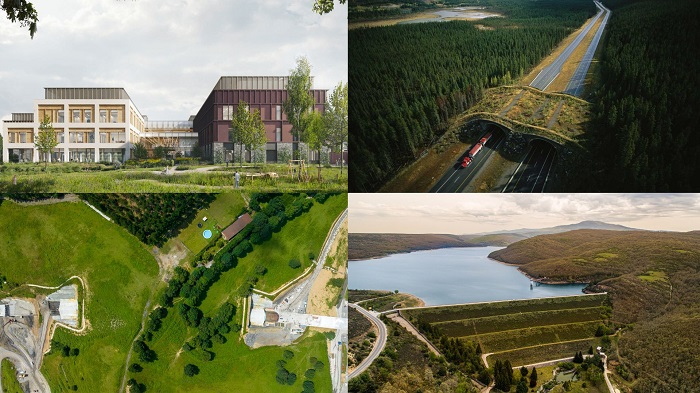ISABEL RUBIO ARROYO | Tungsteno
Animal overpasses that keep wildlife safe, rail projects that use advanced hydroseeding and surplus soil management techniques to restore and enhance the landscape, and hospitals designed with natural materials that respect protected species are just a few examples of infrastructure projects that go beyond meeting human needs. These initiatives demonstrate a strong commitment to sustainability and integration with the natural environment.
A hospital that prioritises biodiversity
An example of environmentally conscious infrastructure is the Velindre Cancer Centre, developed by the Acorn consortium, made up of Sacyr, Kajima Partnerships and Aberdeen. The design of this cancer hospital, located in south-east Wales, prioritises sustainability by incorporating natural materials to reduce its carbon footprint and preserving least 60% of the surrounding land in its natural state. Efforts to protect local biodiversity include initiatives such as monitoring protected species. The facility will also feature solar and geothermal energy systems, and was honoured in the "Future Healthcare Design" category at the 2023 European Healthcare Design Awards.
This hospital is designed to minimise its carbon footprint and preserve biodiversity. Credit: Sacyr
Bridges that save lives
The Wildlife Crossing Project in Banff National Park, Canada, began in 1978 with the goal of reducing animal-vehicle collisions and restoring migratory routes disrupted by the Trans-Canada Highway. The first two animal overpasses were built in 1996 at a cost of $1.5 million each. The project now includes 38 underpasses and six overpasses that span the entire section of highway within the park.
These structures are designed to allow animals to cross the highway safely. In fact, they have reduced animal-vehicle collisions in the area by more than 80%—and by more than 96% for elk and deer, according to the Association of Professional Engineers and Geoscientists of Alberta (APEGA). Species such as grizzly bears, wolves, elk, moose and deer tend to favour overpasses, while cougars and black bears prefer the seclusion of underpasses. From a driver’s perspective, the overpasses look like typical highway bridges. However, as APEGA notes, "catch a glimpse of the top, and it’s clear they cater to a different crowd—the forest stretches from one side to the other, uninterrupted by the highway below."
This animal crossing aims to restore migratory routes and reduce collisions with vehicles. Credit: Parks Canada.
A railway project with a focus on the natural environment
Integrating infrastructure into the natural environment is becoming increasingly important in the development of sustainable projects. The Elorrio-Elorrio railway project in the Basque Country in northern Spain is an example of this approach. Developed by Sacyr Engineering and Infrastructures and Cavosa, in collaboration with Mariezcurrena, this 2.8 kilometre section of double-track platform is a key link in the high-speed railway line connecting three major cities in the region.
The project uses innovative techniques such as hydroseeding, which involves spraying seeds onto slopes and embankments to restore degraded landscapes while minimising the environmental impact. In addition, 850,000 cubic metres of surplus soil were relocated and used to create new embankments, improving the integration of the railway into the natural environment.
The project focuses on the development of the Elorrio-Elorrio high-speed rail section, which is part of the Vitoria-Bilbao-San Sebastián line. Credit: Sacyr
A dam that blends into the landscape
The Úzquiza dam, located in the Arlanzón river basin and managed by Sacyr Conservation, is one of the most modern pieces of infrastructure in the Duero region of Spain. The dam provides drinking water to the city of Burgos and nearby towns and was constructed using loose materials, with a minimum of concrete. According to Sacyr, this technique does not compromise the safety of the dam, while allowing vegetation to naturally integrate the dam into the environment: "The reservoir is so well integrated into the landscape that it could be mistaken for a mountain lake."
The Úzquiza dam was constructed using selected soils. Credit: Sacyr
It is vital that infrastructure is integrated into the environment to minimise its ecological impact and promote long-term sustainability. This helps to preserve biodiversity, reduce the fragmentation of natural habitats and avoid the destruction of local ecosystems, as these initiatives demonstrate. Environmental integration also reduces carbon footprints through the use of renewable energy and sustainable materials. This approach not only benefits the environment, but also promotes public acceptance by creating infrastructure that is in harmony with the natural landscape.
· — —
Tungsteno es un laboratorio periodístico que explora la esencia de la innovación.
